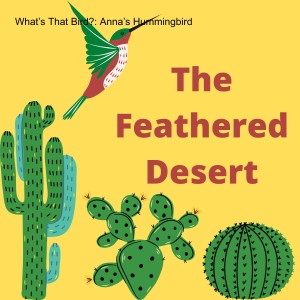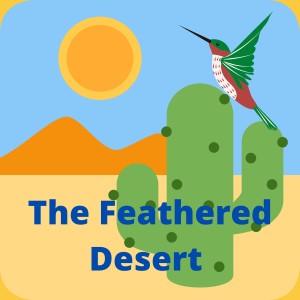
Summary:A three-minute podcast from the hosts of The Feathered Desert about individual bird species found in the desert Southwest.
For our hearing impaired listeners, a transcript of this podcast follows the show notes on Podbean.
Show Notes:Song provided by Macaulay Library at the Cornell Lab of Ornithology, recorded by Nate Peterson
References: The Hummingbird Handbook by John Shewey
Our New email address, please reach out with comments, questions, or suggestions: thefeathereddesert@gmail.com
Transcript
Host voice - Welcome to the Feathered Desert’s What’s That Bird? A three-minute glimpse into the birds that we share this amazing desert landscape with.
Kiersten - Anna’s Hummingbird
This delightful resident of the SW is 3 and ½ to 4 inches in size with an eye-catching coloration including vibrant green on the head and back. Both males and females have a gray under belly. Adult males will have bright, rose red to pink iridescent feathers on the face, crown of the head, and throat with a thick white eye-stripe that cuts through the red feathers. Adult females have a small patch of red or pink feathers on the throat. These feathers are commonly known as gorget feathers. Males use these feathers to mesmerize the females during courtship. The bill of this hummer is dark colored and fairly straight in both sexes.
Here in Arizona we have the Anna’s Hummingbird all year round. Until the 1930’s, the Anna’s breeding range was confined to central and southern California but as people moved north and planted the flowers that hummers like and began offering hummingbird feeders, the Anna’s followed making them the northernmost year-round resident hummingbird. For this little gem, human expansion helped to increase their range and allowed them to survive winter weather. Since this happened so recently in the Anna’s history they never devised a migration path and have had to develop ways to survive the winter weather including relying on human offered nectar and employing torpor, a slowing down of body functions such as the heartbeat, to conserve energy to survive the cold nights. Our warm winter weather here in Arizona is especially attractive because our flowers bloom year round and our residents who love to watch these little wonders offer nectar in feeders all year long.
Anna’s Hummingbirds eat both nectar and small, soft bodied insects such as fruit flies and gnats. This species of hummingbird eats more insects than any other North American hummingbird.
Males and females are extremely territorial and guard their chosen areas aggressively. When you hear this song (Anna’s Hummingbird Song plays) know that you are most likely in the territory of a male Anna’s Hummingbird.
This is The Feathered Desert’s What’s That Bird? Bird song provided by The
Macaulay Library at The Cornell Lab of Ornithology recorded by Nate Peterson.
More Episodes
 2024-02-12
2024-02-12
 94
94
 2024-02-05
2024-02-05
 53
53
 2024-01-29
2024-01-29
 40
40
 2024-01-22
2024-01-22
 56
56
 2024-01-15
2024-01-15
 40
40
 2024-01-08
2024-01-08
 31
31
 2023-12-18
2023-12-18
 50
50
 2023-12-11
2023-12-11
 46
46
 2023-11-27
2023-11-27
 35
35
 2023-11-20
2023-11-20
 46
46
 2023-11-02
2023-11-02
 40
40
 2023-10-30
2023-10-30
 49
49
 2023-10-23
2023-10-23
 44
44
 2023-10-19
2023-10-19
 42
42
 2023-08-28
2023-08-28
 69
69
 2023-08-21
2023-08-21
 36
36
 2023-08-14
2023-08-14
 38
38
 2023-08-07
2023-08-07
 31
31
 2023-07-31
2023-07-31
 29
29
 2023-07-24
2023-07-24
 27
27
Create your
podcast in
minutes
- Full-featured podcast site
- Unlimited storage and bandwidth
- Comprehensive podcast stats
- Distribute to Apple Podcasts, Spotify, and more
- Make money with your podcast
It is Free
- Privacy Policy
- Cookie Policy
- Terms of Use
- Consent Preferences
- Copyright © 2015-2024 Podbean.com






